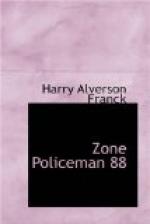Many were the Z.P. facts I picked up during the next few days in the swivel-chair. The Zone Police force of 1912 consisted of a Chief of Police, an Assistant Chief, two Inspectors, four Lieutenants, eight sergeants, twenty corporals, one hundred and seventeen “first-class policemen,” and one hundred and sixteen “policemen” (West Indian negroes without exception, though none but an American citizen could aspire to any white position); not to mention five clerks at headquarters, who are quite worth the mentioning. “Policemen” wore the same uniform as “first-class” officers, with khaki-covered helmet instead of “Texas” hat and canvas instead of leather leggings, drew one-half the pay of a white private, were not eligible for advancement, and with some few notable exceptions were noted for what they did know and the facility with which they could not learn. One Inspector was in charge of detective work and the other an overseer of the uniformed force. Each of the Lieutenants was in charge of one-fourth of the Zone with headquarters respectively at Ancon, Empire, Gorgona, and Cristobal, and the sub-stations within these districts in charge of sergeants, corporals, or experienced privates, according to importance.
Years ago when things were yet in primeval chaos and the memorable sixth of February of 1904 was still well above the western horizon there was gathered together for the protection of the newly-born Canal Strip a band of “bad men” from our ferocious Southwest, warranted to feed on criminals each breakfast time, and in command of a man-eating rough-rider. But somehow the bad men seemed unable to transplant to this new and richer soil the banefulness that had thrived so successfully in the land of sage-brush and cactus. The gourmandizing promised to be chiefly at the criminal tables; and before long it was noted that the noxious gentlemen were gradually drifting back to their native sand dunes, and the rough-riding gave way to a more orderly style of horsemanship. Then bit by bit some men—just men without any qualifying adjective whatever— began to get mixed up in the matter; one after another army lieutenants were detailed to help the thing along, until by and by they got the right army lieutenant and the right men and the Z. P. grew to what it is to-day,—not the love, perhaps, but the pride of every “Zoner” whose name cannot be found on some old “blotter.”
There are a number of ways of getting on the force. There is the broad and general high-way of being appointed in Washington and shipped down like a nice fresh vegetable in the original package and delivered just as it left the garden without the pollution of alien hands. Then there’s the big, impressive, broad-shouldered fellow with some life and military service behind him, and the papers to prove it, who turns up on the Zone and can’t help getting on if he takes the trouble to climb to headquarters. Or there are the special cases, like Marley for instance. Marley blew




